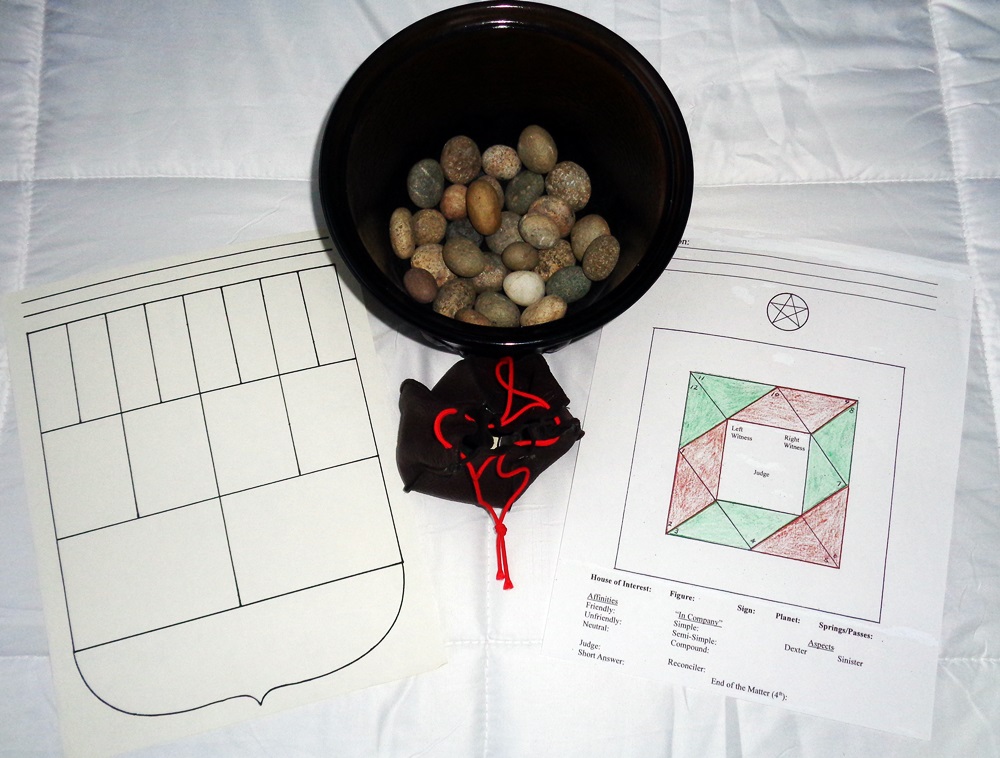AUTHOR’S NOTE: Although I’ve been an astrologer and tarot-card reader for a very long time, over the years I’ve also experimented (separately) with geomancy and I Ching. Here is an analysis of the binary syncretism that exists between the two. (In this essay I’m talking about Western geomancy, not Chinese feng shui.)
Classical, location-based geomantic divination was customarily performed outdoors with a patch of bare earth (or indoors with a “box of dirt”) and a pointed stick (aka “wand”) to poke a random number of holes in the soil, but when I began working with it I adopted Israel Regardie’s method of gathering a collection of small, similarly-sized, smooth stones from my local area (I’ve accumulated three dozen of them to facilitate randomness in the draw) and manually pulling a few of them from a bowl to create odd-and-even subsets that yield the four geomantic “mother” figures. These are captured in four-tiered arrays of single (odd) and double (even) dots, and it doesn’t matter now many of the stones appear in the draw as long as the total can be easily identified as odd or even in number. From the “mothers,” the rest of the figures (daughters, nephews/nieces, witnesses and judge) are generated by either transposition or addition.

Similarly, although I Ching divination was traditionally conducted with a bundle of 50 yarrow stalks and later with coins, there is also a technique by which a bowl of uncooked rice or beans is used as a base population from which to randomly pull an indeterminate handful of representative items (it can number in the hundreds) that is then counted and reduced through division by eight to produce a remainder that will range from zero to seven “left over,” as we used to say in elementary school. The resulting number identifies one of eight three-line trigrams that is used to populate the lower half of the six-line hexagram; this step is performed a second time to complete the figure.
Here is a typical geomantic chart . . .

. . . and here is a tabulation of the 64 I Ching hexigrams (not in ascending order since it was created for a different purpose). Although one is a base-four model and the other is base-six, the binary similarities are obvious.

At their most fundamental, both techniques are binary in nature; one is odd-or-even and the other is active-or-passive. Geomancy – although it is pragmatic and nowhere near as philosophical, lyrical or metaphorical as the I Ching – uses the four-part, odd-or-even symbolism to generate a narrative prediction. Hexagram delineation is much more complex and requires a feel for subtle shades of active and passive meaning in combination; hexagrams can also have changeable “moving lines” that will accord the adjusted figure a new number designation from among the other 63 and thereby modify its complexion, creating an alternate perspective on the matter in question.
I haven’t done enough work with either one, but lately I’ve been inspired to go back and try again. Although I’ve never considered it, translating the geomantic odd-or-even dots into a yin-or-yang format might be an interesting and informative exercise, although it wouldn’t break out conveniently into three-line or six-line sets. Perhaps we could call them “quatregrams” or “quarttograms?” But of course we would then have to write a whole new commentary, and the Asian masters capable of such a feat have all been dead for millennia.
In his 1940 publication *La Géomancie Magique*, French practitioner Robert Ambelain writes at length on the speculative connections between divinatory geomancy and I-Ching. While his theories are largely unsupported by the literature and more formal historical research (see *Terrestrial Astrology* by Stephan Skinner), I have always found his work super interesting. There May still be a PDF somewhere online, and you can use the Google Translate mobile app to read. Thought I’d share.
LikeLiked by 2 people
Thanks! I’ll see if I can find it.
LikeLiked by 1 person